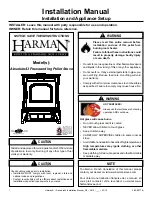
25
Know what type of wood to buy
The logs are lighter
The bark must be partly removed and resent external cracks.
There should be no white or grey colouring.
Check that the wood is dry before using it.
Place a log in the stove on top of a large amount of embers and check for the
following:
Dry wood: It should start burning at more than one point in a question of
minutes.
Damp wood: It turn black and takes some time to light.
Damp and/or green wood: It produces a whistling sound when it burns and
turns dark. It does not produce flames but it does produce large amounts of
smoke.
THIS TYPE OF WOOD IS NOT RECOMMENDED.
REMEMBER THAT:
DAMP WOOD CAUSES PROBLEMS WHEN LIGHTING THE STOVE, PROBLEMS
WITH THE COMBUSTION AND WITH THE MAINTENANCE AND CLEANING OF
THE GLASS PANE.
INITIAL BUNDLE OF
PAPER AND SPLINTERS
3. Light the fire and close the stove
door. *The first time you light the
stove, the paint may emit fumes. We
recommend opening a window.
4. Move the control lever – door
valve towards the right hand side
to provide the maximum amount of
primary air to start the combustion
process and keep it there until the
wood is burning.
5. Open the door and add more
wood, placing the lighter logs on
the burning splinters. It is important
to leave spaces between the logs to
allow air to flow and achieve a faster
and more powerful combustion
proces.
6. Close the door and keep the
control- door valve at the right-hand
position to allow the maximum intake
of primary air. In addition, open the
control- side valve completely to
provide air to clean the glass pane
and maintain the combustion until
the logs are burning.
Lighting the stove
1. Place some paper in the centre of the combustion chamber.
2. Place some splinters on the paper, preferably forming a pyre.
LIGHT THE PAPER
AND SPLINTERS
OPEN TO MAXIMUM
POSITION
LOAD LOGS
OPEN TO
MAXIMUM
POSITION
FULL LOAD TOTAL
COMBUSTION
















































